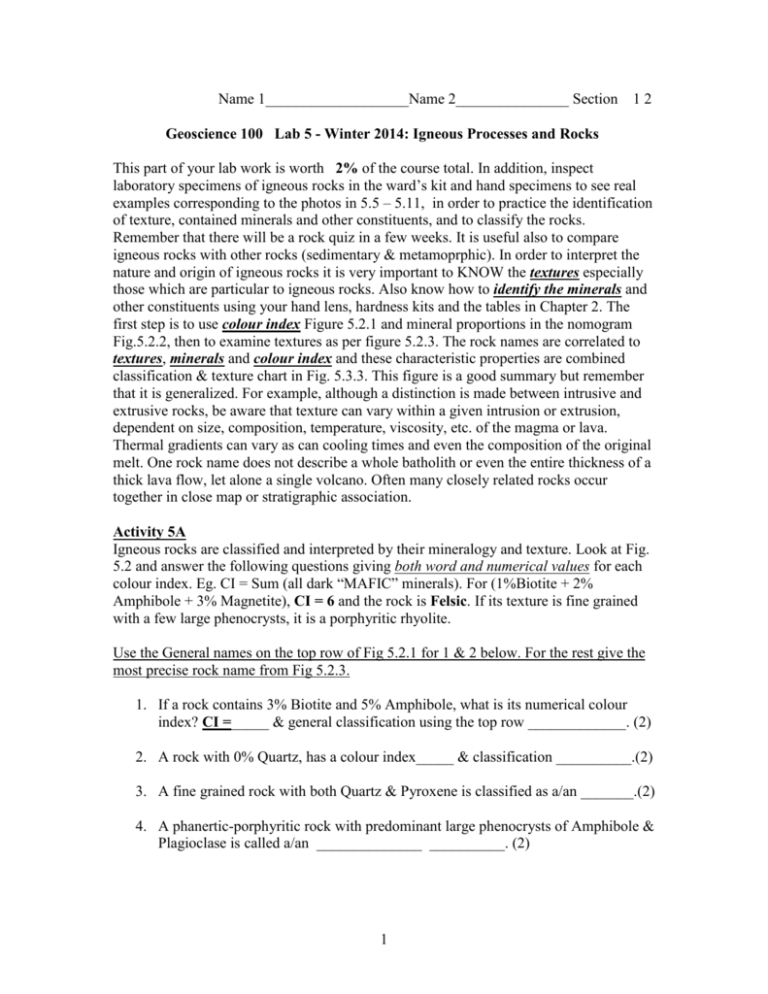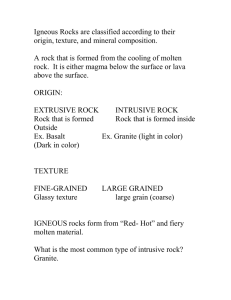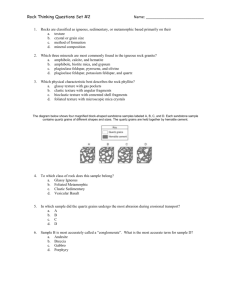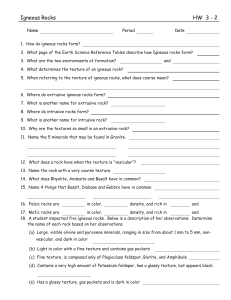Geoscience 100 Igneous Processes and Rocks
advertisement

Name 1___________________Name 2_______________ Section 12 Geoscience 100 Lab 5 - Winter 2014: Igneous Processes and Rocks This part of your lab work is worth 2% of the course total. In addition, inspect laboratory specimens of igneous rocks in the ward’s kit and hand specimens to see real examples corresponding to the photos in 5.5 – 5.11, in order to practice the identification of texture, contained minerals and other constituents, and to classify the rocks. Remember that there will be a rock quiz in a few weeks. It is useful also to compare igneous rocks with other rocks (sedimentary & metamoprphic). In order to interpret the nature and origin of igneous rocks it is very important to KNOW the textures especially those which are particular to igneous rocks. Also know how to identify the minerals and other constituents using your hand lens, hardness kits and the tables in Chapter 2. The first step is to use colour index Figure 5.2.1 and mineral proportions in the nomogram Fig.5.2.2, then to examine textures as per figure 5.2.3. The rock names are correlated to textures, minerals and colour index and these characteristic properties are combined classification & texture chart in Fig. 5.3.3. This figure is a good summary but remember that it is generalized. For example, although a distinction is made between intrusive and extrusive rocks, be aware that texture can vary within a given intrusion or extrusion, dependent on size, composition, temperature, viscosity, etc. of the magma or lava. Thermal gradients can vary as can cooling times and even the composition of the original melt. One rock name does not describe a whole batholith or even the entire thickness of a thick lava flow, let alone a single volcano. Often many closely related rocks occur together in close map or stratigraphic association. Activity 5A Igneous rocks are classified and interpreted by their mineralogy and texture. Look at Fig. 5.2 and answer the following questions giving both word and numerical values for each colour index. Eg. CI = Sum (all dark “MAFIC” minerals). For (1%Biotite + 2% Amphibole + 3% Magnetite), CI = 6 and the rock is Felsic. If its texture is fine grained with a few large phenocrysts, it is a porphyritic rhyolite. Use the General names on the top row of Fig 5.2.1 for 1 & 2 below. For the rest give the most precise rock name from Fig 5.2.3. 1. If a rock contains 3% Biotite and 5% Amphibole, what is its numerical colour index? CI =_____ & general classification using the top row _____________. (2) 2. A rock with 0% Quartz, has a colour index_____ & classification __________.(2) 3. A fine grained rock with both Quartz & Pyroxene is classified as a/an _______.(2) 4. A phanertic-porphyritic rock with predominant large phenocrysts of Amphibole & Plagioclase is called a/an ______________ __________. (2) 1 5. Examine figure 5.2 for classification and 5.3 for the approximate temperature according to the 1st mineral to crystallize in Bowen’s Reaction Series for each rock type below. The percentages of constituent minerals and textures come from examining thin sections. Recall that the CI is only the sum of the mafic or dark coloured minerals, not the felsic ones! Give the CI and identify the corresponding names of the rocks. (a) Aphanitic rock 18% Amphibole, 19% Pyroxene, 59% Plagioclase, 1% K-Feldspar, 3% Quartz CI ____ Name ______________ (2) (b) Pegmatitic rock 8% Amphibole, 5% Biotite, 9% Ca-Plagioclase, 55% K-Feldspar, 4% Muscovite, 25% Quartz CI ____ Name __________ (2) (c) Coarse pyroclastic 8% Biotite, 12% Amphibole, 30% Plagioclase, 3% K-feldspar, 16% Quartz CI ____ Name _______________ (2) (d) Plutonic rock 9% Amphibole, 35% Pyroxene, 51% Olivine, 5% Plagioclase CI ____ Name _____________ (2) Activity 5C: Intrusion & Eruption of Volcanic Landforms & Reading Maps 6. If the rock in question 5(d) came from a 1m-wide dike, how would the texture vary across the intrusion? Examine Figure 5.4 to figure out what mineral crystallizes first, next, … last. Make a careful drawing labeling the minerals & texture across this intrusion from its cold walls to its hot core. Since the dyke comes in hot, it loses the most heat first at the walls. It solidifies at the walls first then cools inwards. Use the crystallization temperatures from Bowen’s Reaction Series on Fig 5.3. (5) Temperature profile (draw T°C profile) Wall Rock _|___________Dyke_______________|__ Wall Rock_____ Texture 2 7. Examine intrusive and extrusive shapes and names in Fig 5.1 & Fig. 5.5. In which type of igneous intrusive body (intrusive shape name) and geological setting (tectonic) would the rock in Question 2 (above) most likely occur? Keep in mind that this is the most common igneous rock type and structure on the planet! Body ____________________ & Tectonic Setting ________________________. (2) 8. Look at Figure 5.3 of Bowen’s Reaction Series and note the relationship of igneous minerals to their respective ranges of crystallization temperature. Note that most common magmas have a crystallization or melting range of about 200°C between the liquidus and the solidus. Once a magma cools by about 200° C it is too stiff to flow or for diffusion to let ions move around and grow any more crystals. This is an “idealized model” subject to “real-world” modifications. Notice the sequence of crystallization from the top of the diagram down and how this relates to the position of minerals as read from right to left on Fig. 5.2. Look at the geology maps of “Victoria” and “Fraser River” on the walls of F300. On the Victoria map there is a legend on the left-hand side of the map. Locate (i) Tm Metchosin volcanics and Tsg Sooke Gabbro (ii) Jg Island Intrusions The detailed descriptions of each of these rock types is given in the legend block on the left hand side of the map. Use Figs 5.2, 5.3 and the map to complete the table: T°C _____ to T°C_____ Rock_______|______Minerals Present |__Texture | Crystallization Range Tm Tsg Jg 3 Activity 5.7 Shiprock NM. Miocene Volcanic Centre in Stereo air photos. Examine the air photos in fig 5.13 then find the corresponding intrusive feature on the block diagram, Fig 5.12. a. What kind of body is labeled A? ___________________ (1) b. What kind of body is labeled B? ___________________ (1) Activity 5.8 Geological map of SE Pennsylvania, Fig 5.14. Examine the inset for the geographic location near the western margin of the Atlantic Ocean, which you’ll recall started forming when Pangea began to rift at about 200 Ma. The brown-tan areas are old Paleozoic basement rocks from a previous Wilson Cycle. The green areas are subhorizontal, 220-200 Ma Permian continental red beds sediments of sands and muds deposited in narrow river valleys, shed off the Paleozoic. The pink areas are 190 Ma Jurassic mafic magmatic rocks. a. Describe the shapes of the pink igneous bodies, interpret their 3 dimensional geometry from the map view and discuss the reasons for your answers: (2) b. Notice the igneous bodies labeled B. Describe these shapes and interpret their 3 dimensional geometry. Explain what do you think they are and discuss your reasons. (2) c. What other landforms must have been present at 180 Ma in this active igneous landscape? Give your reasons. (2) 4 Activity 5.1: Glassy and Vesicular Texture of Igneous Rocks (Candy Lava Flow) Examine the laboratory demonstration put on by your instructor using Sugar, Water, A hot plate and an aluminum foil “river bed” for your lava flow to move down. A. Describe the initial viscosity and temperature of the molten sugar candy lava flow. B. Describe what happened to the viscosity and temperature as the flow moved and hardened. C. Compare the final broken texture of the sugar lava flow to 2 objects in the lab. What can you infer about the cooling history of those other items? D. Observe the texture of the cooled “candy lava” with a hand lens. Note the vesicles of trapped air or steam. What prevented them from leaving the lava? 7. There are 5 large igneous rock specimens and 3 thin sections to inspect in detail in the lab. Describe the 5 hand samples and 3 thin sections and for each specimen: (i) Carefully draw a representative part of its texture, indicating a scale bar on your diagram; (ii) Label the mineral and textural components that you can identify; eg. plagioclase as tabular phenocrysts, quartz infilling vesicles (iii) Suggest the geological environment for each rock and how it formed. e.g. an aphanitic glassy tuff would be formed by a subaerial volcanic eruption. 8. Fill out descriptions of the rock photos in figures 5.6-5.18 on table 5.24. Part II: Drawing specimens (40 points) Draw & label 5 hand specimens and 3 thin sections including a scale bar & correct terms. Hand Spec. A 5 Hand Spec B Hand Spec C Hand Spec D Hand Spec. E. Thin Section No. ______ 6 Thin Section No. _______ Thin Section No. ______ 7








